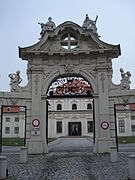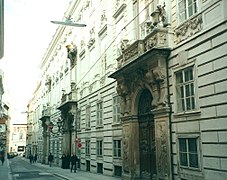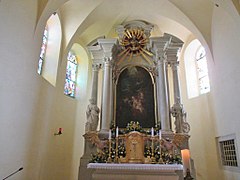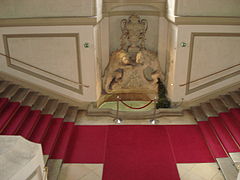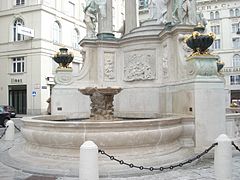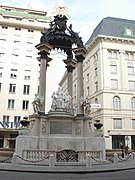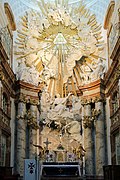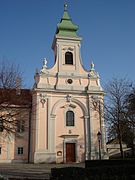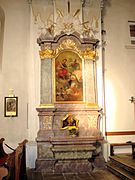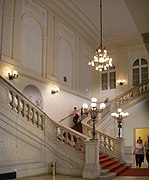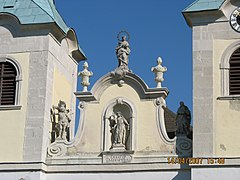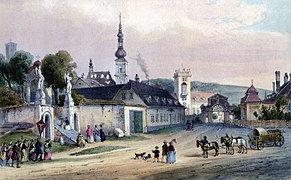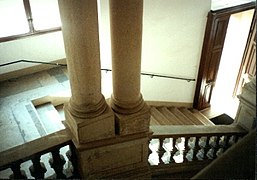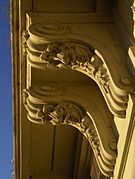Elias Hill
Elias Hügel (also Högl , born June 17, 1681 in Gemünden am Main , Franconia ; † August 22, 1755 in Kaisersteinbruch , Hungary, today Burgenland) was a German-Austrian architect and sculptor . He was the court stone mason of Emperor Karl VI. and church builder of the Heiligenkreuz Abbey .
Elias Hügel learned the art of stonemasonry in Italy, in the Kayserlichen quarry on Leythaberg , an Italian-Swiss artist colony since around 1550. His contemporaries, the two Austrian architects Johann Bernhard Fischer von Erlach and Johann Lucas von Hildebrandt , both of whom had studied in Rome , became he was an employee and matured into an artist.
Life
When he was born, Elias Hügel was a subject of Peter Philipp Reichsgraf von Dernbach , who was also Prince-Bishop of the dioceses of Bamberg and Würzburg. Three sons of the Gemündener shoemaker Johann Franz Hügel learned the stonemason craft: Johann Gallus , who worked as a master in Eggenburg , Lower Austria, in 1692 ; Johann Jacob, who remained in Gemünden, and Elias.
Apprenticeship in the imperial quarry
Elias Hügel was an apprentice at the court stone mason Ambrosius Ferrethi in Kaisersteinbruch in 1694 . His teacher died on February 20, 1696, the brotherhood appointed Master Martin Trumler as his successor. In March 1700, Hügel began training as a sculptor with judge Giovanni Battista Passerini . During the years they worked on orders from Prince Liechtenstein in Vienna.
marriage
Journeyman Elias Hügel, 25 years old, married Maria Elisabetha Trumlerin , who was 44 years old, on November 14, 1706 , the widow of Martin Trumler. Witnesses were Judge Passerini and Johann Carl Trumler , Viennese master stonemasons, as well as Johann Georg Haresleben and Johann Wieser . In 1709, as master of the brotherhood, she had him written down in the land register next to her, with a quarry and two houses.
Salva Guardia privilege for Kaisersteinbruch
Emperor Charles VI. renewed and confirmed on December 5, 1712 the privilege of exemption from military billeting for the masters Johann Georg Haresleben , Sebastian Regondi , Johann Paul Schilck , Elias Hügel, Johann Baptist Kral and Simon Sasslaber . (in this order)
Crafts of stonemasons and masons in Kaisersteinbruch
On December 20, 1714, the emperor approved and renewed the independent craft of stone masons and masons in Kaisersteinbruch .
Pest column Neusiedl 1713
Lower Belvedere , main gate
City palace of Prince Eugene , 3rd construction phase
Karlskirche
During the construction of the Karlskirche , as an employee of Johann Bernhard Fischer von Erlach , he took the step to become an artist. This work brought him much honor, in April 1719 he received the rank of court stone mason . That meant he received orders directly from the imperial court building authority. If necessary, he should pass these on to his fellow masters so that they remain in the brotherhood.
Brother Johann Gallus
Master stonemason Johann Gallus Hügel from the Eggenburg Brotherhood , his older brother , also worked for Fischer von Erlach in the Herzogenburg Abbey at the time .
Master Johann Georg Haresleben organized the monumental stonemason work in the imperial quarry for the imperial church, Elias Hügel was his partner. Both were linked by their marriages in the Ferrethi clan. After Hare's death in 1716, Hügel took over the management. Years later, Maria Regina Synnin, previously a hareslebone, demanded outstanding funds from her stepfather from this working group. The masons Andreas Steinböck and Franz Strickner organized the stone carving in the Eggenburg quarries with the white stone .
Palais Auersperg , detail of the grand staircase
Imperial Court Building Office
Charles VI in 1716 appointed Gundacker Ludwig Graf Althan to the court building director and subordinated all building offices of the hereditary lands to him . Count Althan organized the building activities of the court, such as the Karlskirche, the court library, the marriage fountain, the imperial chancellery wing of the Hofburg. Hügel was directly subordinate to the imperial court building authority and was involved in all these orders.
The masters of the Kaisersteinbruch stonemasonry
Hügel served as judge from 1722 to 1735, his co-masters in these years were Johann Paul Schilck, Johann Baptist Kral, Simon Sasslaber, Johann Wieser , Franz Trumler , Joseph Winkler , Johann Baptist Regondi and Maximilian Trumler .
Winden Church
Hof Palace , stonemason management
Hofburg , Reich Chancellery, balconies, stairs
Harrach Garden Palace, Ungargasse
Marriage in the Königshof chapel
Huegel's wife Maria Elisabetha died on September 5, 1728, his four stepchildren Maria Regina, married Synnin, Franz, Ambrosius and Maximilian received the maternal inheritance. Elias Hügel, 47 years old, married Catharina Dirr on December 26, 1728, daughter of a landlord from Breslau . The wedding ceremony took place in the presence of the master stonemasons Simon Sasslaber, Franz Trumler, as well as Franz Gritsch, castner of the Königshof and Georg Fläschitz, stately hunter. The couple was by Father Ladislaus Frieweiss, profession of Heiligenkreuz been publicly copuliert .
Harrach Garden Palace, Ungargasse, invoice 1730, architect Hildebrandt und Hügel
Wedding fountain , water basin
Mönchhof , architect ?, construction management
In 1730 Hügel bought the broken house with the best Kaiserstein . From his list of works it can be seen that he ran a large stonemasonry company that far surpassed all other Kaisersteinbruch masters. Son Franz Daniel died in March 1735, four of his five children were dead.
The inscriptions on the grave slabs of the children Franz Daniel and Maria Elisabetha read:
- "ALHIER LIGDT BURIED MARIA ELISABETA HIGELLIN HER AGE 2 YEARS 9 MONTHS 24 DAYS. DIED SEPTEMBER 8th, 1733. MY WICK, HOW DID YOU PUSH ME AND HAVE BEEN PUSHED TO YOURSELF UNTIL DEATH. "
- “ALHIER LIGDT BURIED FRANTZ DANNIEL HIGEL AT THE AGE OF 8 MONTHS, DIED ON THE 16TH MARTZI 1735. SON OF THE WORD OF THE UNGODLY PLACES HAVE THE BLOOD HOMELY AFTER… FATHER FORGIVE THEM AND BEFORE THE LORD WANTED ME INTO BEAUTIFUL FACE BE ... TIGES FOREVER. PSALM."
Donor in the Loretto pilgrimage church
May 1735, Elias Huegel and Catharina Our dear women donated to Maria Loretha in Hungarn a capital of 800 guilders. (For comparison: Prince Esterházy with 1,000 guilders) At that time he owned three stone quarries, five houses and his own forge. In February 1736 son Joseph Elias was born.
Mönchhofer Church, chancel
Purbach Anna Chapel
Altar and church builder
With the power of imagination he developed “his” altar , made of hard white stone. The slender, lateral pillars open up to a “gate for the human being” who works for justice and direct the gaze to the Trinity. The gilded capitals with towering entablature point directly into the heavenly realm.
Honor column for Elias Hill
The lordly administrator in the Königshof Palace officiated as the deputy of the Heiligenkreuz abbot and determined the lives of the people in the quarry. The local pastor, always a priest of the monastery, the teacher, the landlord, the butcher , also the thirties in the Heiligenkreuzer quarry were appointed by the administrator and were obliged to him. Father Raymund Vitali ruled from 1723 to 1740 in the sense of an inquisitor , he responded to the judge Elias Hügel's efforts for freedom by dishonorably removing him from the judge's office. The fellow masters of the brotherhood were called upon to severely accuse those who wanted to be independent in a letter to the authorities . He was not allowed to defend himself against this.
When the pressure eased after Father Raymund's death, the brotherhood erected an Elias Hügel column of honor in 1740 for the sake of justice , which today stands in ruins in front of the Königshof Palace.
“Incidentally, the hill has to be rejected in all seriousness for the immodesty used by the Vorgewester Commission, the impertinent humiliation and the respect it has lost to the Commission.
- He should also abstain from such violations in the case of real staff arrest . "
The sons died, two daughters married in ennobled circles , Catharina Mr. Johann von Naszvady , judge of the Wieselburg Comitat , and Maria Franziska the Franz Antoni Cichini, imperial postmaster at Wimpassing an der Leitha .
Salva Guardia privilege for Kaisersteinbruch
That of her father Emperor Karl VI. The privilege granted to be exempt from military billeting was renewed and confirmed in 1743 for the masters Elias Hügel, Joseph Winkler , Johann Baptist Regondi , Maximilian Trumler , Johann Paul Schilck and Franz Trumler .
Hill as a wine merchant
The prior of the Discalced Carmelites in the desert near Mannersdorf am Leithagebirge in Lower Austria bought 39 buckets of 4 guilders each 30 kreuzers from "a certain Herr Hügel" in Kaisersteinbruch to replenish his stock of old wine .
As the successor to Johann Baptist Regondi, the Kaisersteinbrucher elected him a second time as judge from the three-way proposal of the monastery in 1749. At the end of 1751, at the age of 70, he gave up. His successor was master Johann Michael Strickner von Eggenburg .
The masters of the Kaisersteinbruch stonemasonry
Hügel served as judge from 1749 to 1751, his co-masters in these years were Johann Gehmacher , Johann Baptist Regondi, Andreas Kowalt, Johann Michael Strickner , Maximilian Trumler .
Imperial letter from Maria Theresa
As a judge, he turned to his Empress, Maria Theresa commented on March 6, 1750 on the issues between Abbot Robert Leeb of Heiligenkreuz Abbey and his subjects, the residents of the "Steinbruch" estate. She demands that a possible solution to the dispute does not lead to an injustice for the residents who are subject to the tax ... With gracious benevolence, your Empress and Queen.
- Maria Theresia (handwritten signature)
- Count Leopold von Nádasdy
An apprentice from Master Hill
In 1717 Georg Doppler was an apprentice from Salzburg and acquitted as a journeyman in 1722 . As a master he built marble altars in the branch church of St. Lorenz am Mondsee in the area of the Salzburg guild , in Stadl-Paura in the parish church of St. Johann in Tirol .
High altar of the parish church of Stotzing
Parish Church of Stotzing : In 1749 Elias Hügel created his artistic will, the Marien Altar of the pilgrimage church in Stotzing . The art historian Ana-Maria Altmann writes: “ Chiseled in sandstone and marbled in a bichromatic manner, this altar is characterized by a range of imaginative formulations. Illusionistic effects, such as the light-flooded halo, give it (...) solemnity. In the small provincial town of Stotzing (near the pilgrimage site of Loretto ), the Kaisersteinbruch master stonemason sets an example for the triumph of the church in pomp and glory . With this masterpiece he also realizes a symbol for everything that baroque art meant in terms of balance between earthly and heavenly life. "
“A two-pillar retable unfolds above a two-storey plinth , the middle part of which occupies a figural niche. In its central point stands the figure of the crowned Mother of God , surrounded by small adoring angels . Above it rises (...) the altarpiece, in the inner field of which the halo is located.
Not only the elegant, curved, almost theatrical structure of the altar (...) but also the solution of the play of light and shadow achieve a harmonious view from the real into the unreal space. "
The Stotzinger high altar is the last (known), certainly the most mature and still completely preserved among Hügel's altars.
death
On August 22nd, 1755 Elias Hügel died and was buried in front of “his” cross altar. The side chapel of the Kaisersteinbruch church became the hill chapel, its epitaph, that of Maria Elisabetha, his first wife, and three children are attached there. Widow Catharina married the noble Mr. Franz von Frid, Doctor Philosophiae et Medicina in Vienna
Elias Hill left a fortune of about 50,000 guilders. This legacy was contested for the next ten years. The Heiligenkreuz Abbey demanded the widow for sums of money that were owed in court. Numerous files in the archives Mosonmagyaróvár and Stift Heiligenkreuz attest to this.
In the 1960s, the stone portal of his estate was relocated from Kaisersteinbruch to Sommerein. The large portal with its stonemason mark and the year 1723 was so artfully installed that in Dehio Lower Austria south of the Danube, part 2, 2003, S 2254, you can read: Sommerein, Schloßstraße No. 22, former home of the stonemason Elias Hügel , baroque three-sided courtyard; middle portal wall with square basket arch portal, in the Keilstein marked 1723. The rest of the text is consistent. This ensemble was built into an existing baroque complex. Elias Hill did not live there!
Commemoration
The sculptor symposium Kaisersteinbruch in 1992 was named Elias Hill Symposium in his honor . In Kaisersteinbruch there is Elias Hügelgasse , in Winden am See there is Elias Hygel-Gasse . In 1996, his hometown Gemünden am Main had an honorary column erected by the Hungarian sculptor Ferenc Gyurcsek on the newly created Elias-Hügel-Platz . The painting Apotheosis of Elias Hügel by the artist Raja Schwahn-Reichmann can be found in the parish church of Kaisersteinbruch .
Elias Hill Badge of Honor
After ten years together, chairman Helmuth Furch presented his employees with this 2.3 cm brass thank you sign. The sculptor Alexandru Ciutureanu presented the master's mark from the side altar (hilltop altar) with the artist's signature for the occasion .
additional
The stonemason's mark by Meister Hügel is carved on the Kaisersteinbruch local stone by the sculptor Alexandru Ciutureanu .
Works
- 1713/1714: Trinity column at Neusiedl am See
- 1715–1730: Karlskirche in Vienna , initially with Haresleben , 1716 overall management in the imperial quarry, finally working on the high altar. Architect Johann Bernhard Fischer von Erlach
- 1716: Lower Belvedere Palace , architect Johann Lucas von Hildebrandt
- 1720–1725: Upper Belvedere Palace in Vienna, general management.
- 1720: Kaisersteinbrucher church , high altar, brotherhood
- 1721–1723: Palais Auersperg in Vienna.
- 1723: Trinity Column Sommerein
- 1724–1726: Church of Winden , church builder, patron
- 1725–1729: Hof Palace , Prince Eugen. Steinmetzleitung
- 1726–1728: Vienna Hofburg , Imperial Chancellery wing. Order of Charles VI. , Balconies, Kaiserstiege etc. architect Joseph Emanuel Fischer von Erlach
- 1727–1735: Palais Harrach (Ungargasse) , with his stepson Franz Trumler the ornate main portal, the steps of the main staircase and all the architectural stones, including in the garden.
- 1729–1732: Hoher Markt wedding fountain in Vienna, … architecture from Hofsteinmetz Hügel , sculptor Antonio Corradini .
- 1729–1735: Stift Heiligenkreuz , Dreifaltigkeitssäule, Kaiserstein for the lower and upper pedestal on which the column stands . Design and sculpture Giov. Giuliani .
- 1729–1737: Mönchhof parish church , commissioned by Heiligenkreuz Abbey , church builder + high altar (with Giuliani and Altomonte ), side altars according to his plan.
- 1738: Kaisersteinbruch, in its side chapel a cross altar and stonemason's mark , on the right a Marienaltar
- 1742: Altar in the St. Anna chapel in Purbach
- 1745: Baroque renovation and expansion of the Kaisersteinbruch Church (2 towers, round gable)
- 1745: Hofburg , ambassadorial steps, commissioned by Maria Theresa, architect Jean Nicolas Jadot de Ville-Issey
- 1745–1747: Heiligenkreuz Abbey , Wiener Tor, plan by Franz Anton Pilgram
- 1746–1748: Hofburg, colonnaded staircase, as above.
- 1749–1750: Marien Altar, Stotzinger Church, commissioned by Prior Servite Monastery , Hügel's plan, his old work.
- 1752: Imperial Court Building Authority, large arbor for the Leopoldine wing of the Hofburg
- 1755: His epitaph carved by himself
literature
- Högl Elias and family. In: Felix Czeike : Historisches Lexikon Wien. Volume 3. 1994.
- Helmuth Furch : Elias Huegel, master stone mason. 1681-1755. Kaisersteinbruch 1992, ISBN 978-3-9504555-2-6 .
- Anneliese Lussert : One of them moved out and became famous (Elias Hügel). Audio picture on Bayerischer Rundfunk , written down in No. 22.
- The Hügel family from Gemünden am Main. No. 42.
- Helmuth Furch: Elias Hügel, architectural artist. Kaisersteinbruch 2005, ISBN 978-3-9504555-6-4 .
- Gunnar Strunz: Burgenland, nature and culture between Lake Neusiedl and the Alps, Elias hill. Trescher Verlag, Berlin 2012, ISBN 978-3-89794-221-9 , pp. 76, 112f.
- Brigitte Krizsanits, Manfred Horvath : The Leithagebirge, border and connection, Elias hill. Pp. 78, 94, 145
Web links
- Helmuth Furch 1992/2015: Elias Huegel - Hofsteinmetz. with the picture: Apotheosis of Elias Huegel (PDF; 23.9 MB)
- Helmuth Furch Elias Hügel 2005, the large order Karlskirche determined his life with the image: Apotheosis of Elias Hügel
- Kaisersteinbruch in Ticino artists in Europe.
- The mystery of the “beheaded” statue of a saint solved - Neusiedl am See.
Individual evidence
- ^ Diocesan archive of Würzburg : Gemünden parish register from 1598
- ^ Architect Friedrich Kurrent after studying the Stotzinger Marien Altar
- ↑ Harald Prickler : From the history of an Italian artist colony (Kaisersteinbruch), Radio Burgenland on June 27, 1973, manuscript in: Mitteilungen des Museums- und Kulturverein Kaisersteinbruch . Volume 9, No. 52, December 1998, ISBN 978-3-9504555-3-3 .
- ↑ Alfons Pfrenzinger: Main Franconian emigration to Hungary and Austrian hereditary lands. Series of publications on German research in Hungary, directed by Franz Anton Basch . Vienna 1941.
- ↑ Hans Kietaibl: The brotherhood of bricklayers and stonemasons in Kaisersteinbruch 1714. In: Helmuth Furch: Elias Hügel, Hofsteinmetzmeister. 1681-1755 .
- ↑ Hofkammerarchiv Vienna: Court Pay Office Books 1715–1730, Karlskirche and Camerale Pay Office Books , Hofbauamtsakten
- ↑ Herbert Haupt: The handicrafts freed from court and court in baroque Vienna 1620 to 1770 (= research and contributions to the history of the city of Vienna. No. 46). Studien-Verlag, Innsbruck / Vienna / Bozen 2007, ISBN 978-3-7065-4342-2 .
- ↑ Protocols of the Königshoffen rule 1728 - 1731
- ^ Hungarian State Archives, Budapest: Deed of foundation May 28, 1735.
- ↑ Since 2017 on the Kirchenplatz in Kaisersteinbruch
- ↑ Hofkammerarchiv old post files: Franz Antoni Cichini, postmaster at Wimpassing an der Leitha. In: Messages from the Kaisersteinbruch Museum and Culture Association . No. 21, July 1992, pp. 4-11.
- ↑ Archive Mosonmagyarovar No 36/1494 Royal Decree of Maria Theresa.
- ↑ Colonel Albert Schatek: The Chapters of the desert. 1935/1936.
- ^ Archives Mosonmagyaróvár
- ^ Alois Kieslinger : The usable rocks of Salzburg. 1964, p. 289.
- ↑ Article by the art historian Ana-Maria Altmann from September 25, 2001
- ↑ URL: https://regiowiki.at/index.php?title=Helmuth_Furch&oldid=176545
- ^ Vienna City and State Archives : Paul Harrer-Lucienfeld , Vienna, its people, culture and buildings . Wedding fountain. 1955
- ↑ Heiligenkreuz Abbey Archive: Stonemason contract for the Holy Trinity Column on October 4, 1729, Wiener Tor, chapel in Königshof
| personal data | |
|---|---|
| SURNAME | Hill, Elias |
| ALTERNATIVE NAMES | Högl, Elias |
| BRIEF DESCRIPTION | Kaisersteinbrucher Hofsteinmetzmeister of Kaiser Karl VI. , Church builder of the Heiligenkreuz Abbey and judge in Kaisersteinbruch |
| DATE OF BIRTH | June 17, 1681 |
| PLACE OF BIRTH | Gemünden am Main |
| DATE OF DEATH | August 22, 1755 |
| PLACE OF DEATH | Kaisersteinbruch |




